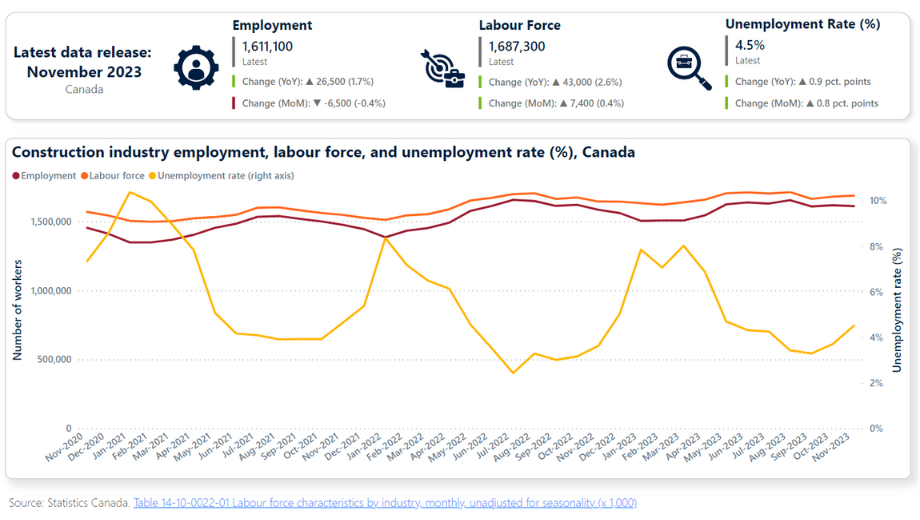Construction labour pressures ease in November, with notable growth among women
Data from Statistics Canada’s November Labour Force Survey (LFS) shows employment pressures gradually easing across the country as the year draws to a close.
National, all-industry employment grew by 0.1% for the month, adding 25,000 workers. November marked the second consecutive month in which employment gains have been muted. Meanwhile, the national employment rate, which is the proportion of the working-age population that is employed, fell by 0.1 percentage points for the month. Both occurred as the labour force grew by 0.2%, or 78,000 people.
As a function of these trends, the national, all-industry unemployment rate rose 0.1 percentage points to 5.8% in November. Since April, it has risen by a total of 0.8 percentage points, with increases most pronounced among youth.
Construction labour pressures may be easing as the sector adds more women
Construction’s data follow similar patterns.
The industry’s unadjusted unemployment rate rose by 0.9 percentage points in November, compared with a year ago. The rate also rose by 0.8 percentage points compared with October 2023, although this figure is likely due to the nature of seasonal employment.

Employment levels rose between November 2022 and 2023, adding 26,500 workers over the year, or 1.7%. November’s total of 1.61 million workers was down slightly (-6,500; -0.4%) from October, again likely due to seasonality.
Meanwhile, the industry’s total labour force stood at 1.68 million people in November. That figure was up by 43,000 workers, or 2.6%, from November 2022, and up slightly (0.4%) from October.
Driving these changes, in part, has been a significant increase in the number of women working in the construction sector. The number of women in the labour force reached 212,500 in November 2023. That was an increase of 20,700 (10.8%) over November 2022 levels. That increase outpaced the overall year-over-year labour force increase for the sector of 2.6%.
Labour force growth was particularly strong among women under 24 years of age. The number of people in that cohort rose by 79% – from 10,500 in November 2022 to 18,800 in November 2023. Women in the core working age group of 25 to 54 years of age also increased, but by a more muted 13.4%.
Overall, the construction labour force increased by 2.5% in the core working age group of 25- to 54-year-olds, and by 2.1% in the youth cohort. The number of workers 55 years of age and older declined by 0.1%.
Provincial figures vary
Across the provinces, and on a year-over year basis, Nova Scotia recorded the steepest decrease in the labour force, down by 12.7% from November 2022 levels. British Columbia and Newfoundland and Labrador followed with declines of 3.2% and 1.9% respectively. Alberta, Prince Edward Island, and New Brunswick all reported labour force gains greater than 5%, while Ontario and Quebec – the provinces with the largest construction labour forces – recorded year-over-year gains of 2.8% and 2.7% respectively.
Prince Edward Island has led the way in terms of year-over-year increases in employment, recording a 12.3% increase. Alberta and New Brunswick followed with rates of 9.3% and 6.2%. Manitoba, Quebec, Saskatchewan, and Ontario also recorded increases of less than 4%, while Nova Scotia, Newfoundland and Labrador, and British Columbia experienced decreases under 9% in year-over-year employment.
The unemployment rate was lowest in Nova Scotia in November at 1.3%, followed by British Columbia (4%), Quebec (4.1%), and Manitoba (4.2%). Ontario, Prince Edward Island, and British Columbia also recorded unemployment rates below the national average of 4.5% for the month. Newfoundland and Labrador recorded the highest rate of unemployment at 16%, followed by New Brunswick at 10.3% and Saskatchewan at 4.9%.

